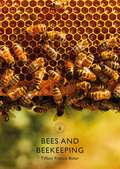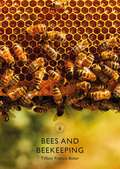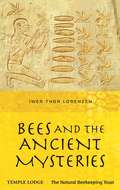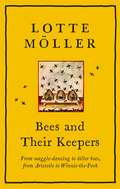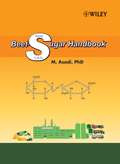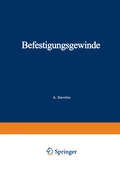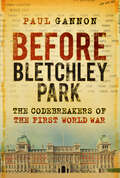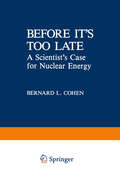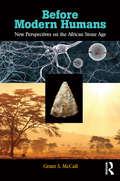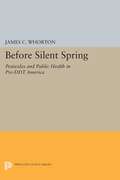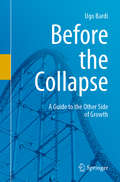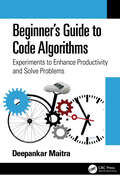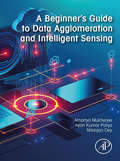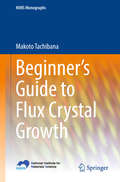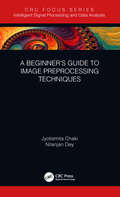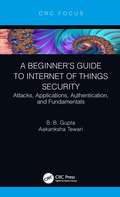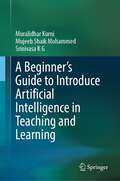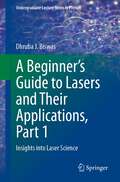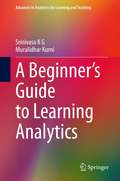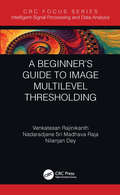- Table View
- List View
Bees and Beekeeping (Shire Library)
by Tiffany Francis-BakerBees existed long before human beings, but our future is perhaps more reliant upon them than any other species. They pollinate 80 per cent of the world's crops and plants, but how much do we really know about them? Small, clever and mysterious, the honeybee in particular has long been celebrated in human culture as a sacred insect, a symbol of the sun, bridging the gap between our world and the next. They are expert communicators, skilled aviators and natural alchemists, turning fresh nectar into sweet, golden honey. They are also in trouble and need our help. This beautifully illustrated guide explores the honeybee's historic relationship with humans, the basics of beekeeping, and how we can help save the bees' dwindling population.
Bees and Beekeeping (Shire Library)
by Tiffany Francis-BakerBees existed long before human beings, but our future is perhaps more reliant upon them than any other species. They pollinate 80 per cent of the world's crops and plants, but how much do we really know about them? Small, clever and mysterious, the honeybee in particular has long been celebrated in human culture as a sacred insect, a symbol of the sun, bridging the gap between our world and the next. They are expert communicators, skilled aviators and natural alchemists, turning fresh nectar into sweet, golden honey. They are also in trouble and need our help. This beautifully illustrated guide explores the honeybee's historic relationship with humans, the basics of beekeeping, and how we can help save the bees' dwindling population.
Bees and the Ancient Mysteries
by Iwer Thor LorenzenIn an extraordinary exposition, Lorenzen – an expert beekeeper and student of contemporary spiritual science – describes the ‘Logos mysteries’, based at the ancient temple of Artemis in Ephesus, where priestesses were known as ‘Melissas’ (‘honeybees’) and the sacrificial priests were called ‘Essenes’ (or ‘bee-kings’). These cultic mysteries, he says, bore remarkable parallels to the workings of a bee colony – specifically in the relationship between the queen and worker bees to the spiritual ‘group-soul’ of the bees.Lorenzen commences his unique study with a discussion of flowers and insects, exploring their common origins. He then describes the beginnings of the honeybee, its connection with the fig wasp, and the subsequent controlled transformation of the latter that took place in pre-historic mystery-centres. Breeding the honeybee from the fig wasp – a sacred deed performed at consecrated sanctuaries – was part of the ‘Fig-tree mysteries’. The initiates behind this task developed the ability to commune with the bees’ group-soul and to work consciously on the mutual development of the hive and humanity.This concise but rich work features an illuminating foreword by Heidi Herrmann of the Natural Beekeeping Trust as well as a lucid introduction by translator Paul King that explains the anthroposophical concepts employed by Lorenzen in his text.
Bees and Their Keepers: Through the seasons and centuries, from waggle-dancing to killer bees, from Aristotle to Winnie-the-Pooh
by Lotte MöllerA beautifully illustrated and thoroughly engaging cultural history of beekeeping - packed with anecdote, humour and enriching historical detail. The perfect gift."A charming look at the history of beekeeping, from myth and folklore to our practical relationship with bees" Gardens IllustratedBeekeeper and garden historian Lotte Möller explores the activities inside and outside the hive while charting the bees' natural order and habits. With a light touch she uses her encyclopaedic knowledge of the subject to shed light on humanity's understanding of bees and bee lore from antiquity to the present. A humorous debunking of the myths that have held for centuries is matched by a wry exploration of how and when they were replaced by fact. In her travels Möller encounters a trigger-happy Californian beekeeper raging against both killer bees and bee politics, warring beekeepers on the Danish island of Læso, and Brother Adam of Buckfast Abbey, breeder of the Buckfast queen now popular throughout Europe and beyond, as well a host of others as passionate as she about the complex world of apiculture both past and present.Translated from the Swedish by Frank Perry - Sweden's Gardening Book of the Year 2019, shortlisted for the August Prize 2019
Beet-Sugar Handbook
by Mosen AsadiThe first all-in-one reference for the beet-sugar industry Beet-Sugar Handbook is a practical and concise reference for technologists, chemists, farmers, and research personnel involved with the beet-sugar industry. It covers: * Basics of beet-sugar technology * Sugarbeet farming * Sugarbeet processing * Laboratory methods of analysis The book also includes technologies that improve the operation and profitability of the beet-sugar factories, such as: * Juice-softening process * Molasses-softening process * Molasses-desugaring process * Refining cane-raw sugar in a beet-sugar factory The book ends with a review of the following: * Environmental concerns of a beet-sugar factory * Basics of science related to sugar technology * Related tables for use in calculations Written in a conversational, engaging style, the book is user friendly and practical in its presentation of relevant scientific and mathematical concepts for readers without a significant background in these areas. For ease of use, the book highlights important notes, defines technical terms, and presents units in both metric and British systems. Operating problem-solving related to all stations of sugarbeet processing, frequent practical examples, and given material/energy balances are other special features of this book.
Befestigungsgewinde: Gegenüberstellung der DIN-Normen mit der amerikanischen Norm ASA B 1.1–1949
by A. SievrittsBefore Bletchley Park: The Codebreakers of the First World War
by Paul GannonThe story of Bletchley Park’s codebreaking operations in the Second World War is now well known, but its counterparts in the First World War – Room 40 & MI1(b) – remain in the shadows, despite their involvement in and influence on most of the major events of that war. From the First Battle of the Marne, the shelling of Scarborough, the battles of Jutland and the Somme in 1916, to the battles on the Western Front in 1918, the German naval mutiny and the Zimmermann Telegram, this cast of characters – several of them as eccentric as anyone from Bletchley Park in the Second World War – secretly guided the outcome of the ‘Great War’ from the confines of a few smoke-filled rooms. Using hundreds of intercepted and decrypted German military, naval and diplomatic messages, bestselling author Paul Gannon reveals the fascinating story of British codebreaking operations. By drawing on many newly discovered archival documents that challenge misleading stories about Room 40 & MI1(b), he reveals a sophisticated machine in operation.
Before it’s Too Late: A Scientist’s Case for Nuclear Energy
by B.L. CohenI was not invited to write a foreword for this book. Dr. Cohen, knowing my busy schedule, would have considered such a request to be an imposition. I volunteered to do so in part to acknowledge my gratitude to him for having been a constant source of reference materials as I have turned my attention increasingly to informing both lay and scientific audiences concerning the biologic effects of low-level ionizing radiation. My primary reason for vol unteering, however, is to point to the importance of such a book for public education at a time when the media, in collaboration with a variety of activist groups, have developed among the people an almost phobic fear of radiation at any level. I take issue with the words of another Nobel laureate, George Wald, who states regularly "Every dose is an overdose. '" This philosophy has re sulted in women refusing mammography for the detection of breast cancer even though this methodology is the most sensitive for detection of such cancers in the early, curable stage, and even though, at present, breast cancer is the leading cause of cancer deaths among women. It has led a Westchester County, New York legislator to state proudly in the New York Times that he v vi I FOREWORD had introduced legislation that would bar all radioactivity from the county's roads.
Before Modern Humans: New Perspectives on the African Stone Age
by Grant S. McCallThis fascinating volume, assessing Lower and Middle Pleistocene African prehistory, argues that the onset of the Middle Stone Age marks the origins of landscape use patterns resembling those of modern human foragers. Inaugurating a paradigm shift in our understanding of modern human behavior, Grant McCall argues that this transition—related to the origins of “home base” residential site use—occurred in mosaic fashion over the course of hundreds of thousands of years. He concludes by proposing a model of brain evolution driven by increasing subsistence diversity and intensity against the backdrop of larger populations and Pleistocene environmental unpredictability. McCall argues that human brain size did not arise to support the complex patterns of social behavior that pervade our lives today, but instead large human brains were co-opted for these purposes relatively late in prehistory, accounting for the striking archaeological record of the Upper Pleistocene.
Before Modern Humans: New Perspectives on the African Stone Age
by Grant S. McCallThis fascinating volume, assessing Lower and Middle Pleistocene African prehistory, argues that the onset of the Middle Stone Age marks the origins of landscape use patterns resembling those of modern human foragers. Inaugurating a paradigm shift in our understanding of modern human behavior, Grant McCall argues that this transition—related to the origins of “home base” residential site use—occurred in mosaic fashion over the course of hundreds of thousands of years. He concludes by proposing a model of brain evolution driven by increasing subsistence diversity and intensity against the backdrop of larger populations and Pleistocene environmental unpredictability. McCall argues that human brain size did not arise to support the complex patterns of social behavior that pervade our lives today, but instead large human brains were co-opted for these purposes relatively late in prehistory, accounting for the striking archaeological record of the Upper Pleistocene.
Before Silent Spring: Pesticides and Public Health in Pre-DDT America (PDF)
by James C. WhortonModern consumers are well aware that the food they eat is tainted by pesticidal residues; they are less aware that their great-grandparents faced the same hazard. James C. Whorton's history of this public health menace emphasizes that insecticides have been contaminating produce since the introduction of chemical pesticides in the 1860s.The book examines the period before the publication of Rachel Carson's famous Silent Spring, tracing the origins of the residue problem and exploring the complicated network of interest groups that formed around the issue. The author shows how economic necessities, technological limitations, and pressures on regulatory agencies have brought us to "our present dilemma of seemingly having to poison our food in order to protect it." In Part I, the agricultural and medical literature of the past century is used to analyze the emergence by 1920 of a public health danger of serious proportions. Part II draws heavily on the unpublished records of the Food and Drug Administration to document how the ineffective handling of this danger established precedents for present pesticide abuses.Originally published in 1975.The Princeton Legacy Library uses the latest print-on-demand technology to again make available previously out-of-print books from the distinguished backlist of Princeton University Press. These editions preserve the original texts of these important books while presenting them in durable paperback and hardcover editions. The goal of the Princeton Legacy Library is to vastly increase access to the rich scholarly heritage found in the thousands of books published by Princeton University Press since its founding in 1905.
Before the Collapse: A Guide to the Other Side of Growth
by Ugo BardiNobody has to tell you that when things go bad, they go bad quickly and seemingly in bunches. Complicated structures like buildings or bridges are slow and laborious to build but, with a design flaw or enough explosive energy, take only seconds to collapse. This fate can befall a company, the stock market, or your house or town after a natural disaster, and the metaphor extends to economies, governments, and even whole societies. As we proceed blindly and incrementally in one direction or another, collapse often takes us by surprise. We step over what you will come to know as a “Seneca cliff”, which is named after the ancient Roman philosopher, Lucius Annaeus Seneca, who was the first to observe the ubiquitous truth that growth is slow but ruin is rapid. Modern science, like ancient philosophy, tell us that collapse is not a bug; it is a feature of the universe. Understanding this reality will help you to see and navigate the Seneca cliffs of life, or what Malcolm Gladwell called “tipping points.” Efforts to stave off collapse often mean that the cliff will be even steeper when you step over it. But the good news is that what looks to you like a collapse may be nothing more than the passage to a new condition that is better than the old.This book gives deeper meaning to familiar adages such as “it’s a house of cards”, “let nature take its course”, “reach a tipping point”, or the popular Silicon Valley expression, “fail fast, fail often.” As the old Roman philosopher noted, “nothing that exists today is not the result of a past collapse”, and this is the basis of what we call “The Seneca Strategy.” This engaging and insightful book will help you to use the Seneca Strategy to face failure and collapse at all scales, to understand why change may be inevitable, and to navigate the swirl of events that frequently threaten your balance and happiness. You will learn:How ancient philosophy and modern science agree that failure and collapse are normal features of the universePrinciples that help us manage, rather than be managed by, the biggest challenges of our lives and times Why technological progress may not prevent economic or societal collapseWhy the best strategy to oppose failure is not to resist at all costsHow you can “rebound” after collapse, to do better than before, and to avoid the same mistakes.
Begin Again
by Oliver JeffersA powerful, thoughtful and bold comment on humanity and its future from one of today’s most thought-provoking artists.
Beginner's Guide to Code Algorithms: Experiments to Enhance Productivity and Solve Problems
by Deepankar MaitraDo you have creative ideas that you wish you could transform into code?Do you want to boost your problem solving and logic skills?Do you want to enhance your career by adopting an algorithmic mindset?In our increasingly digital world, coding is an essential skill. Communicating an algorithm to a machine to perform a set of tasks is vital. Beginner’s Guide to Code Algorithms: Experiments to Enhance Productivity and Solve Problems written by Deepankar Maitra teaches you how to think like a programmer. The author unravels the secret behind writing code – building a good algorithm. Algorithmic thinking leads to asking the right question and enables a shift from issue resolution to value creation. Having this mindset will make you more marketable to employers. This book takes you on a problem-solving journey to expand your mind and increase your willingness to experiment with code. You will: Learn the art of building an algorithm through hands-on exercises Understand how to develop code for inspiring productivity concepts Build a mentality of developing algorithms to solve problems Develop, test, review, and improve code through guided experimentation This book is designed to develop a culture of logical thinking through intellectual stimulation. It will benefit students and teachers of programming, business professionals, as well as experienced users of Microsoft Excel who wish to become proficient with macros.
Beginner's Guide to Code Algorithms: Experiments to Enhance Productivity and Solve Problems
by Deepankar MaitraDo you have creative ideas that you wish you could transform into code?Do you want to boost your problem solving and logic skills?Do you want to enhance your career by adopting an algorithmic mindset?In our increasingly digital world, coding is an essential skill. Communicating an algorithm to a machine to perform a set of tasks is vital. Beginner’s Guide to Code Algorithms: Experiments to Enhance Productivity and Solve Problems written by Deepankar Maitra teaches you how to think like a programmer. The author unravels the secret behind writing code – building a good algorithm. Algorithmic thinking leads to asking the right question and enables a shift from issue resolution to value creation. Having this mindset will make you more marketable to employers. This book takes you on a problem-solving journey to expand your mind and increase your willingness to experiment with code. You will: Learn the art of building an algorithm through hands-on exercises Understand how to develop code for inspiring productivity concepts Build a mentality of developing algorithms to solve problems Develop, test, review, and improve code through guided experimentation This book is designed to develop a culture of logical thinking through intellectual stimulation. It will benefit students and teachers of programming, business professionals, as well as experienced users of Microsoft Excel who wish to become proficient with macros.
A Beginner's Guide to Data Agglomeration and Intelligent Sensing
by Nilanjan Dey Amartya Mukherjee Ayan Kumar PanjaA Beginners Guide to Data Agglomeration and Intelligent Sensing provides an overview of the Sensor Cloud Platform, Converge-casting, and Data Aggregation in support of intelligent sensing and relaying of information. The book begins with a brief introduction on sensors and transducers, giving readers insight into the various types of sensors and how one can work with them. In addition, it gives several real-life examples to help readers properly understand concepts. An overview of concepts such as wireless sensor networks, cloud platforms, and device-to-cloud and sensor cloud architecture are explained briefly, as is data gathering in wireless sensor networks and aggregation procedures. Final sections explore how to process gathered data and relay the data in an intelligent way, including concepts such as supervised and unsupervised learning, software defined networks, sensor data mining and smart systems. Presents the latest advances in data agglomeration for intelligent sensingDiscusses the basic concepts of sensors, real-life applications of sensors and systems, the protocols and applications of wireless sensor networks, the methodology of sensor data accumulation, and real-life applications of Intelligent Sensor NetworksProvides readers with an easy-to-learn and understand introduction to the concepts of the cloud platform, Sensor Cloud and Machine Learning
Beginner’s Guide to Flux Crystal Growth (NIMS Monographs)
by Makoto TachibanaThis book introduces the principles and techniques of crystal growth by the flux method, which is arguably the most useful way to obtain millimeter- to centimeter-sized single crystals for physical research. As it is possible to find an appropriate solvent (“flux”) for nearly all inorganic materials, the flux method can be applied to the growth of many crystals ranging from transition metal oxides to intermetallic compounds. Both important principles and experimental procedures are described in a clear and accessible manner. Practical advice on various aspects of the experiment, which is not readily available in the literature, will assist the beginning graduate students in setting up the lab and conducting successful crystal growth. The mechanisms of crystal growth at an elementary level are also provided to better understand the techniques and to help in assessing the quality of the crystals. The book also contains many photographs of beautiful crystals with important physical properties of current interest, such as high-temperature superconductors, strongly correlated electronic systems, topological insulators, relaxor ferroelectrics, low-dimensional quantum magnets, non-linear optical materials, and multiferroics.
A Beginner’s Guide to Image Preprocessing Techniques (Intelligent Signal Processing and Data Analysis)
by Jyotismita Chaki Nilanjan DeyFor optimal computer vision outcomes, attention to image pre-processing is required so that one can improve image features by eliminating unwanted falsification. This book emphasizes various image pre-processing methods which are necessary for early extraction of features from the image. Effective use of image pre-processing can offer advantages and resolve complications that finally results in improved detection of local and global features. Different approaches for image enrichments and improvements are conferred in this book that will affect the feature analysis depending on how the procedures are employed. Key Features Describes the methods used to prepare images for further analysis which includes noise removal, enhancement, segmentation, local, and global feature description Includes image data pre-processing for neural networks and deep learning Covers geometric, pixel brightness, filtering, mathematical morphology transformation, and segmentation pre-processing techniques Illustrates a combination of basic and advanced pre-processing techniques essential to computer vision pipeline Details complications to resolve using image pre-processing
A Beginner’s Guide to Internet of Things Security: Attacks, Applications, Authentication, and Fundamentals
by B. B. Gupta Aakanksha TewariA Beginner’s Guide to Internet of Things Security focuses on security issues and developments in the Internet of Things (IoT) environment. The wide-ranging applications of IoT, including home appliances, transportation, logistics, healthcare, and smart cities, necessitate security applications that can be applied to every domain with minimal cost. IoT contains three layers: application layer, middleware layer, and perception layer. The security problems of each layer are analyzed separately to identify solutions, along with the integration and scalability issues with the cross-layer architecture of IoT. The book discusses the state-of-the-art authentication-based security schemes, which can secure radio frequency identification (RFID) tags, along with some security models that are used to verify whether an authentication scheme is secure against any potential security risks. It also looks at existing authentication schemes and security models with their strengths and weaknesses. The book uses statistical and analytical data and explains its impact on the IoT field, as well as an extensive literature survey focusing on trust and privacy problems. The open challenges and future research direction discussed in this book will help to further academic researchers and industry professionals in the domain of security. Dr. Brij B. Gupta is an assistant professor in the Department of Computer Engineering, National Institute of Technology, Kurukshetra, India. Ms. Aakanksha Tewari is a PhD Scholar in the Department of Computer Engineering, National Institute of Technology, Kurukshetra, India.
A Beginner’s Guide to Internet of Things Security: Attacks, Applications, Authentication, and Fundamentals
by B. B. Gupta Aakanksha TewariA Beginner’s Guide to Internet of Things Security focuses on security issues and developments in the Internet of Things (IoT) environment. The wide-ranging applications of IoT, including home appliances, transportation, logistics, healthcare, and smart cities, necessitate security applications that can be applied to every domain with minimal cost. IoT contains three layers: application layer, middleware layer, and perception layer. The security problems of each layer are analyzed separately to identify solutions, along with the integration and scalability issues with the cross-layer architecture of IoT. The book discusses the state-of-the-art authentication-based security schemes, which can secure radio frequency identification (RFID) tags, along with some security models that are used to verify whether an authentication scheme is secure against any potential security risks. It also looks at existing authentication schemes and security models with their strengths and weaknesses. The book uses statistical and analytical data and explains its impact on the IoT field, as well as an extensive literature survey focusing on trust and privacy problems. The open challenges and future research direction discussed in this book will help to further academic researchers and industry professionals in the domain of security. Dr. Brij B. Gupta is an assistant professor in the Department of Computer Engineering, National Institute of Technology, Kurukshetra, India. Ms. Aakanksha Tewari is a PhD Scholar in the Department of Computer Engineering, National Institute of Technology, Kurukshetra, India.
A Beginner's Guide to Introduce Artificial Intelligence in Teaching and Learning
by Muralidhar Kurni Mujeeb Shaik Mohammed Srinivasa K GThis book reimagines education in today’s Artificial Intelligence (AI) world and the Fourth Industrial Revolution. Artificial intelligence will drastically affect every industry and sector, and education is no exception. This book aims at how AI may impact the teaching and learning process in education. This book is designed to demystify AI for teachers and learners. This book will help improve education and support institutions in the phenomena of the emergence of AI in teaching and learning. This book presents a comprehensive study of how AI improves teaching and learning, from AI-based learning platforms to AI-assisted proctored examinations. This book provides educators, learners, and administrators on how AI makes sense in their everyday practice. Describing the application of AI in ten key aspects, this comprehensive volume prepares educational leaders, designers, researchers, and policymakers to effectively rethink the teaching and learning process and environments that students need to thrive. The readers of this book never fall behind the fast pace and promising innovations of today’s most advanced learning technology.
A Beginner’s Guide to Lasers and Their Applications, Part 1: Insights into Laser Science (Undergraduate Lecture Notes in Physics)
by Dhruba J. BiswasThis two-volume book provides an enriching insight into the laser, covering different types of lasers, the basic science behind the technology, their role at the cutting-edge of current scientific research, and their wide-ranging applications. With just high school physics as a prerequisite and favoring qualitative yet scientifically sound explanations over high-level mathematics, this book is aimed at a broad spectrum of readers in physics, chemistry, engineering, medicine, and biology. Its engaging and lucid presentation is enhanced with plenty of illustrations, making the world of the laser accessible to undergraduate students in the sciences and any other inquisitive readers with high school physics under their belts. Furthermore, the text is often laced with anecdotes, picked from history, that are bound to pique the minds of the readers. It is ideal for self-study or as a complement to courses on optics and optoelectronics. This volume, Part 1 of 2, explains the fundamentals of optics, what a laser is, how it works, and what is unique about the light it emits, from fundamental quantum theory through population inversion and cavity to common laser types. It is followed by Part 2 which depicts the many advances in science enabled by the laser, including spectroscopy, nonlinear optics, optical cooling and trapping, and optical tweezers, among many others, and provides a glimpse into the ways that the laser affects our lives via its uses in medicine, manufacturing, the nuclear industry, energy, defence, communication, ranging, pollution monitoring, art conservation, fashion, beauty, and entertainment.
A Beginner’s Guide to Learning Analytics (Advances in Analytics for Learning and Teaching)
by Srinivasa K G Muralidhar KurniThis book A Beginner’s Guide to Learning Analytics is designed to meet modern educational trends’ needs. It is addressed to readers who have no prior knowledge of learning analytics and functions as an introductory text to learning analytics for those who want to do more with evaluation/assessment in their organizations. The book is useful to all who need to evaluate their learning and teaching strategies. It aims to bring greater efficiency and deeper engagement to individual students, learning communities, and educators.Covered here are the key concepts linked to learning analytics for researchers and practitioners interested in learning analytics. This book helps those who want to apply analytics to learning and development programs and helps educational institutions to identify learners who require support and provide a more personalized learning experience. Like chapters show diverse uses of learning analytics to enhance student and faculty performance. It presents a coherent framework for the effective translation of learning analytics research for educational practice to its practical application in different educational domains. This book provides educators and researchers with the tools and frameworks to effectively make sense of and use data and analytics in their everyday practice. This book will be a valuable addition to researchers’ bookshelves.
A Beginner’s Guide to Multilevel Image Thresholding (Intelligent Signal Processing and Data Analysis)
by Venkatesan Rajinikanth Nadaradjane Sri Madhava Raja Nilanjan DeyA Beginner’s Guide to Image Multi-Level Thresholding emphasizes various image thresholding methods that are necessary for image pre-processing and initial level enhancement. Explains basic concepts and the implementation of Image Multi-Level Thresholding (grayscale and RGB images) Presents a detailed evaluation in real-time application, including the need for heuristic algorithm, the choice of objective and threshold function, and the evaluation of the outcome Describes how the image thresholding acts as a pre-processing technique and how the region of interest in a medical image is enhanced with thresholding Illustrates integration of the thresholding technique with bio-inspired algorithms Includes current findings and future directions of image multi-level thresholding and its practical implementation Emphasizes the need for multi-level thresholding with suitable examples The book is aimed at graduate students and researchers in image processing, electronics engineering, computer sciences and engineering.
A Beginner’s Guide to Multilevel Image Thresholding (Intelligent Signal Processing and Data Analysis)
by Venkatesan Rajinikanth Nadaradjane Sri Madhava Raja Nilanjan DeyA Beginner’s Guide to Image Multi-Level Thresholding emphasizes various image thresholding methods that are necessary for image pre-processing and initial level enhancement. Explains basic concepts and the implementation of Image Multi-Level Thresholding (grayscale and RGB images) Presents a detailed evaluation in real-time application, including the need for heuristic algorithm, the choice of objective and threshold function, and the evaluation of the outcome Describes how the image thresholding acts as a pre-processing technique and how the region of interest in a medical image is enhanced with thresholding Illustrates integration of the thresholding technique with bio-inspired algorithms Includes current findings and future directions of image multi-level thresholding and its practical implementation Emphasizes the need for multi-level thresholding with suitable examples The book is aimed at graduate students and researchers in image processing, electronics engineering, computer sciences and engineering.
